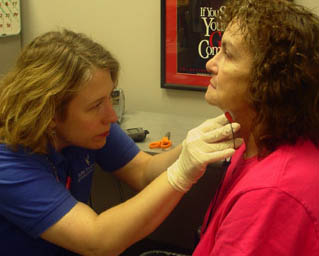FLOWOOD, Miss.—Before Alice Allen of Philadelphia had a stroke, she never thought twice about gulping down a big glass of water. Now the simple act is rife with complications. She has to mix the liquid with a thickening agent, then tuck her chin to her chest as she swallows.
It’s a common struggle for people who suffer from dysphagia—a swallowing disorder caused by illness or injury. But a new therapy offered at Methodist Rehabilitation Center’s outpatient clinic in Flowood is giving patients like Allen hope of eating and drinking normally again.
Called VitalStim, the innovative therapy uses neuromuscular electrical stimulation to re-educate and strengthen the throat muscles used for swallowing, said Methodist speech pathologist Lisa Saxton.
After gaining Food and Drug Administration clearance in 2001, VitalStim became available for clinical use in 2003, said Shelley Jones, a speech pathologist and sales rep for VitalStim distributor TheraQuip, Inc. Methodist became the first Jackson-area hospital to provide the service in August.
Jones said therapists are clamoring for the system because it’s the only FDA-cleared device of its kind to stimulate the muscle fibers needed for a safe and efficient swallow. “About 4,200 clinicians are now using the therapy and they’ve reported a more than 75 percent success rate,” she said. “We no longer have to accept that the best we can do is help patients compensate for their swallowing difficulties. We now have the potential to correct the problem and ‘fix’ the swallow.”
Saxton predicts she’ll have no problem finding patients who could benefit from the therapy. “It’s estimated that about half of Americans over age 60 will experience a swallowing disorder,” she said. “As many as 50 to 75 percent of stroke patients struggle with dysphagia, and it’s responsible for the majority of respiratory infections in that population.”
Infections happen because people who can’t swallow properly tend to aspirate liquids or food particles into their lungs, Saxton said. “Instead of going into the esophagus like it’s supposed to, it goes into the airway. Normally, a person would cough that up. Because patients with decreased sensations in their throat can’t do that, they are at a higher risk for aspiration pneumonia.”
Saxton said Allen is especially vulnerable because she is a “silent aspirator.” “Things go straight down her airway and she doesn’t know it.” As a result, Allen’s diet is limited to thickened liquids and soft foods. “Some patients have to stay on feeding tubes because it’s not safe to take anything by mouth,” Saxton said.
Knowing what a hardship that can be, Saxton said she was excited to learn about VitalStim’s effectiveness. “I have talked to speech pathologists whose patients improved months and years after their initial swallowing problems.”
Saxton attended a two-day training session to be certified to use VitalStim. “The training is extensive,” she said. “Before you go, you even have to take an online course to refresh your knowledge of head and neck muscles and the modified barium swallowing test.” Saxton said the test helps pinpoint the specific throat muscles that need to be stimulated by the VitalStim electrodes.
The electrodes deliver a maximum of 25 milli-amps of electricity. “It’s a sharp sting at first, then it feels like it’s grabbing the muscles,” Allen said. “It doesn’t exactly hurt, but you know it’s there.”
Saxton said she supplements VitalStim sessions with traditional therapies such as oral motor exercises and swallowing maneuvers like the chin tuck. “We’re not turning away from the old ways,” she said. “VitalStim just augments what we already do. It’s like having more tools in our war chest.” VitalStim sessions last 60 minutes, and after several rounds of the treatment Allen is showing signs of progress. “Her voice is already stronger,” Saxton said.
And if all goes as planned, Allen may be using that stronger voice to order the makings of a celebratory dinner once she finishes therapy. “I would like a Coca-Cola and I’ve been craving coleslaw,” she said. “It will be so good to sit down and eat anything I want without worrying about it.”

